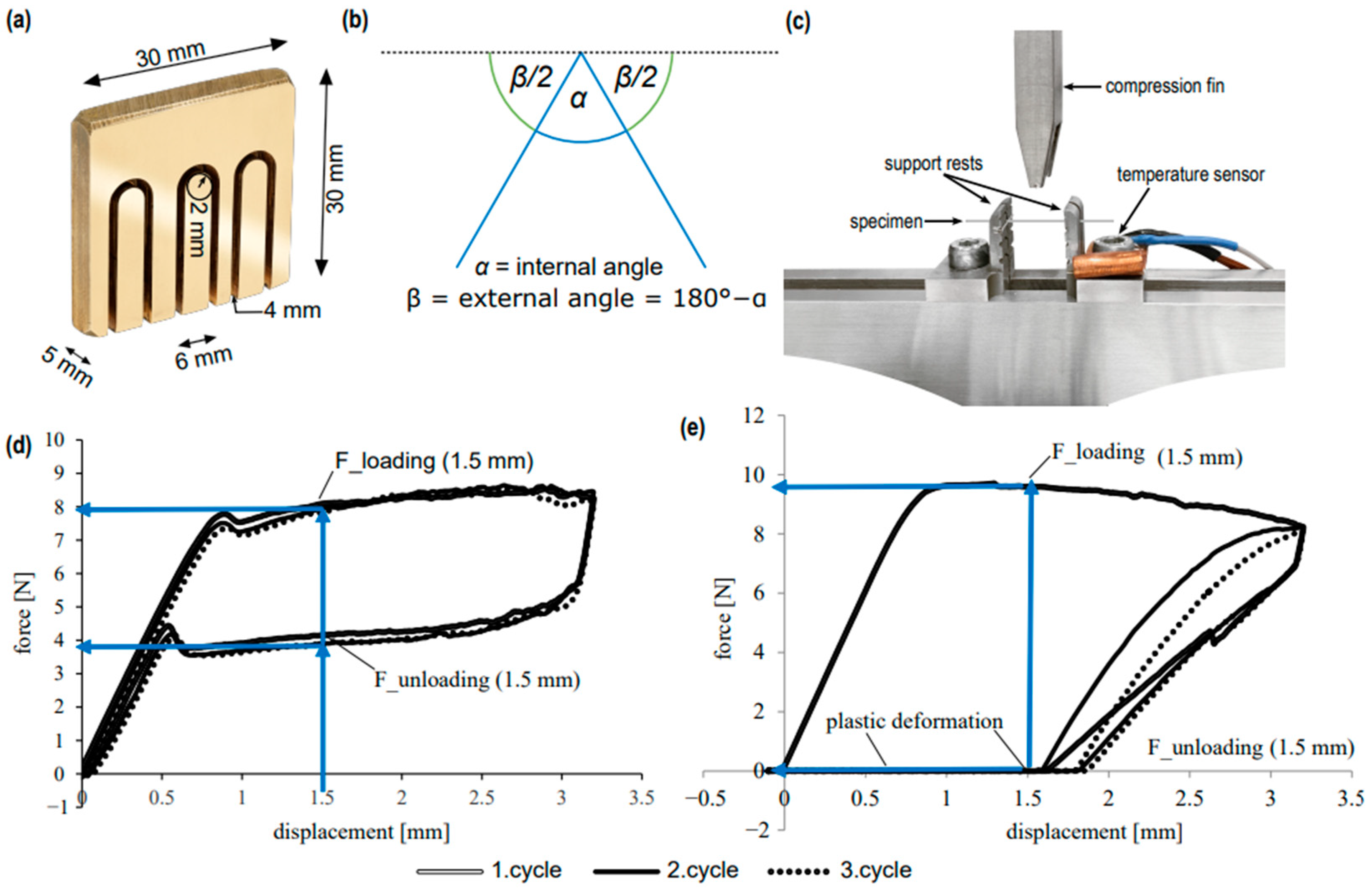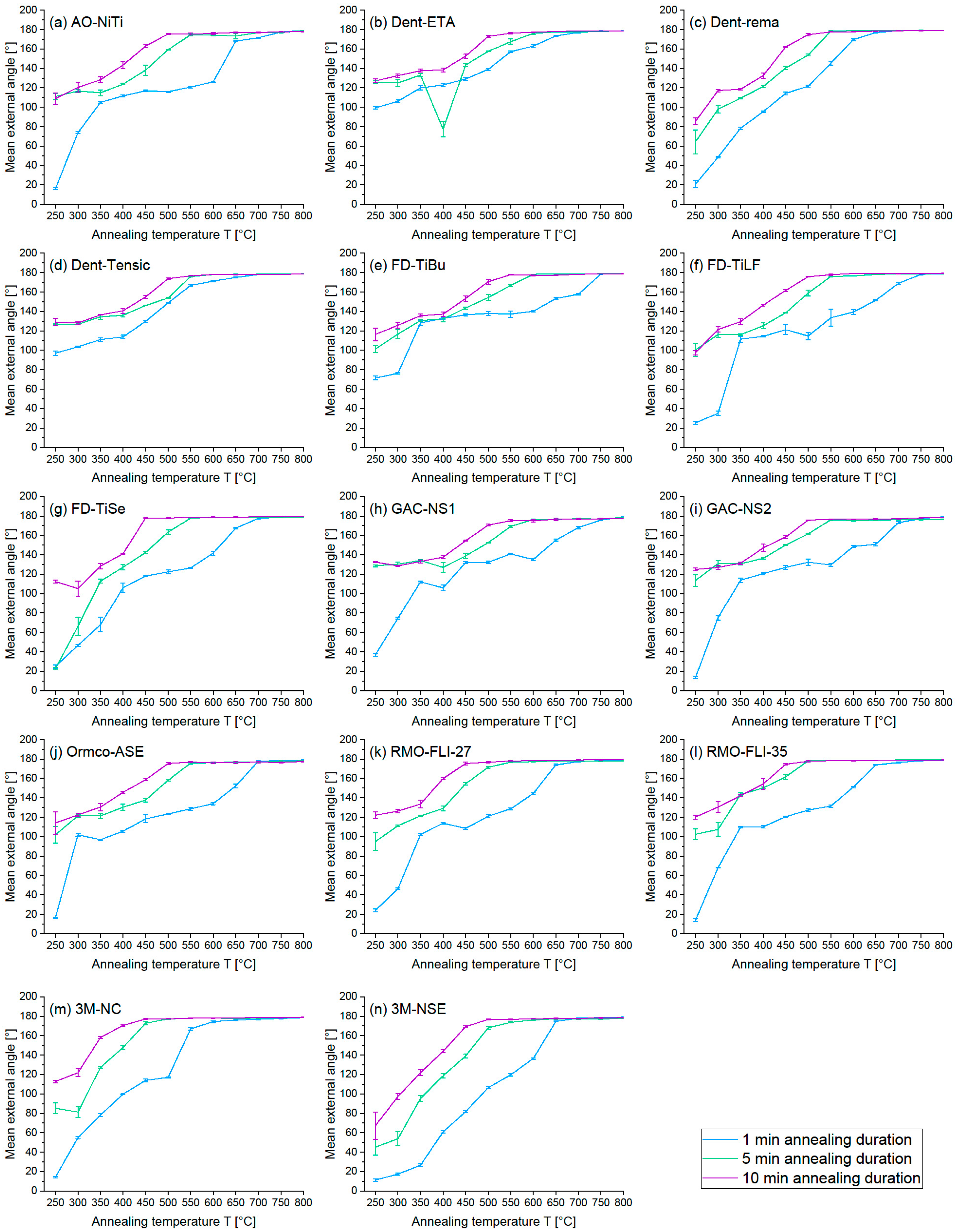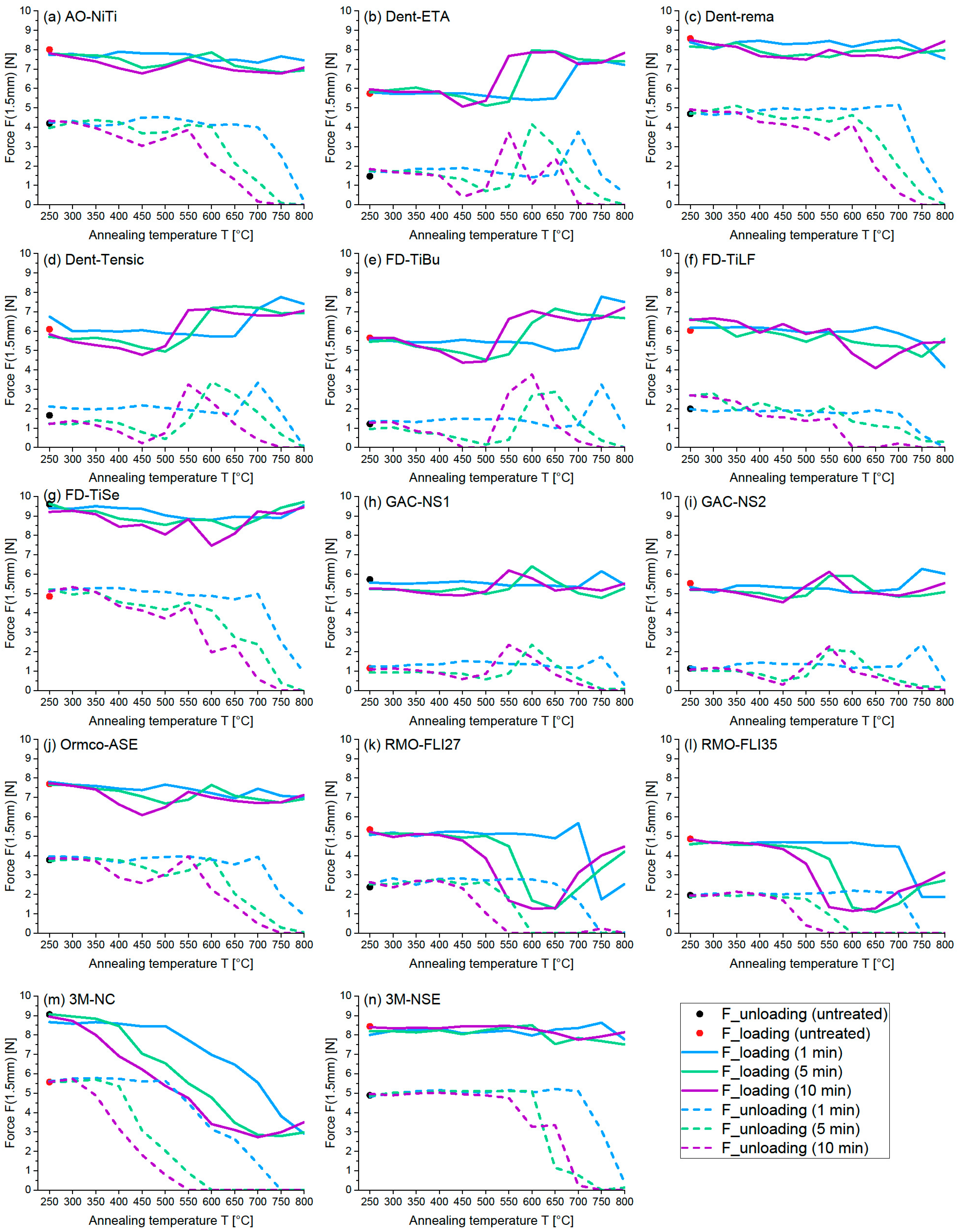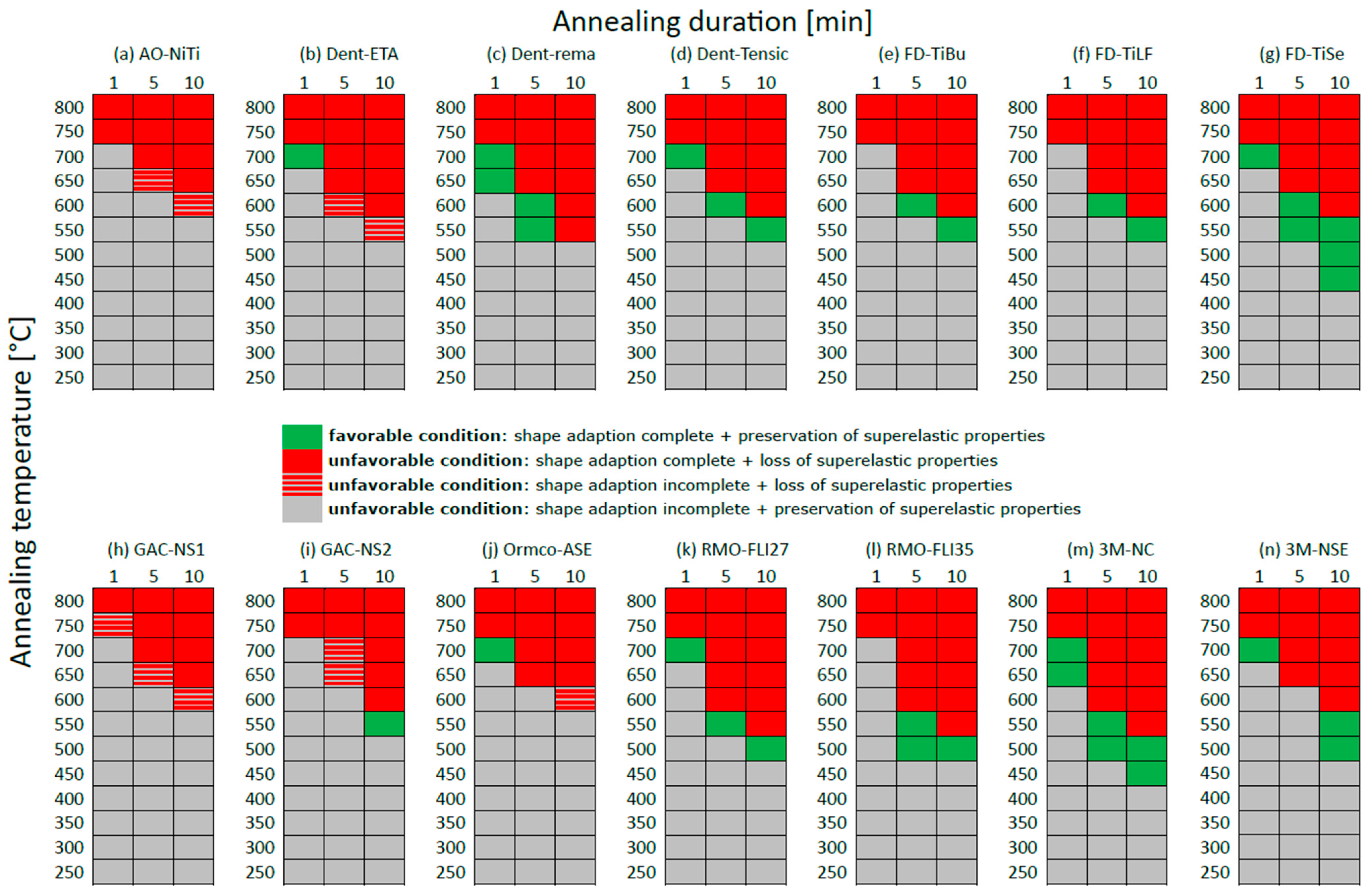Thermal Programming of Commercially Available Orthodontic NiTi Archwires
Abstract
1. Introduction
2. Materials and Methods
- -
- Length of the straight u-shaped legs: 20 mm;
- -
- Distance between the two u-shaped legs: 6 mm;
- -
- Arch radius of the u-shaped grooves: 2 mm;
- -
- Engraving depth: 4 mm.
- A low loading and unloading force in the upper and lower plateau level to minimize periodontal damage.
- Stable force values up to high annealing temperature ranges. This expresses that a wire was insensitive to heat treatments in terms of its mechanical properties.
- A force drop with a low inclination (not steep) after high annealing temperatures or annealing times, which means that the wire’s properties do not change spontaneously once a critical temperature is reached.
- A monotonic curve with few fluctuations, as any change in force could lead to inadequate orthodontic results.
3. Results
3.1. Angle Measurements
3.2. Results of the Three-Point Bending Tests
3.3. Detection of Favourable Working Ranges and Total Scores Achieved in the Three-Point Bending Score
- -
- -
- -
4. Discussion
- -
- Changes in transformation sequence (occurrence of R-phase after lower heat treatment temperatures and higher amounts of cold work applied during wire manufacturing).
- -
- Growth of Ni-rich Ni4Ti3 precipitates, leading to an increase of transformation temperatures during heat treatment due to loss of Ni from the matrix. The process is diffusion controlled and depends on the dislocation density because dislocations are nucleation sites for precipitation during subsequent annealing.
- -
- Recovery and recrystallisation during heat treatments at higher temperatures, leading to a softening of the material and reducing the resistance against plastic deformation, as well as the nucleation sites for further precipitation.
- (1)
- Wires which exhibited relatively stable force values F_loading (1.5 mm) until the transition to the plastic state and only reacted with a drop in force in the plastic state:AO-NiTi, Dent-rema, FD-TiLF/TiSe, Ormco-ASE and wires from RMO and 3M Unitek.Due to their stable force levels over a wide heat treatment range, these wires were regarded as user-friendly for thermal shape-setting.
- (2)
- Wires with force peaks followed by force drops before transitioning to the plastic state:Dent-ETA/-Tensic, FD-TiBu and GAC wires.These wires were regarded as problematic for thermal shape-setting since the observed force peaks after heat treatment could lead to clinical side effects, e.g., the risk for orthodontically induced inflammatory root resorption was shown to be increased when heavy orthodontic forces are applied [17].
5. Conclusions
Author Contributions
Funding
Institutional Review Board Statement
Informed Consent Statement
Data Availability Statement
Acknowledgments
Conflicts of Interest
References
- Alzahawi, K.; Faerovig, E.; Brudvik, P.; Boe, O.E.; Mavragani, M. Root resorption after leveling with super-elastic and conventional steel arch wires: A prospective study. Prog. Orthod. 2014, 15, 35. [Google Scholar] [CrossRef] [PubMed]
- Wichelhaus, A.; Dulla, M.; Sabbagh, H.; Baumert, U.; Stocker, T. Stainless steel and NiTi torque archwires and apical root resorption. J. Orofac. Orthop. 2021, 82, 1–12. [Google Scholar] [CrossRef] [PubMed]
- Casa, M.A.; Faltin, R.M.; Faltin, K.; Arana-Chavez, V.E. Root resorption on torqued human premolars shown by tartrate-resistant acid phosphatase histochemistry and transmission electron microscopy. Angle Orthod. 2006, 76, 1015–1021. [Google Scholar] [CrossRef] [PubMed]
- Stoyanova-Ivanova, A.; Georgieva, M.; Petrov, V.; Andreeva, L.; Petkov, A.; Georgiev, V. Effects of Clinical Use on the Mechanical Properties of Bio-Active® (BA) and TriTanium® (TR) Multiforce Nickel-Titanium Orthodontic Archwires. Materials 2023, 16, 483. [Google Scholar] [PubMed]
- Munir, A.; Razali, M.F.; Hassan, M.H.; Franz, G. Effect of Short-Term Ageing Treatment on Bending Force Behavior of Commercial Nickel-Titanium Archwire. Materials 2023, 16, 1008. [Google Scholar] [CrossRef] [PubMed]
- Artun, J.; Garol, J.D.; Little, R.M. Long-term stability of mandibular incisors following successful treatment of Class II, Division 1, malocclusions. Angle Orthod. 1996, 66, 229–238. [Google Scholar] [CrossRef] [PubMed]
- Brauchli, L.M.; Keller, H.; Senn, C.; Wichelhaus, A. Influence of bending mode on the mechanical properties of nickel-titanium archwires and correlation to differential scanning calorimetry measurements. Am. J. Orthod. Dentofacial. Orthop. 2011, 139, e449–e454. [Google Scholar] [CrossRef] [PubMed]
- Khier, S.E.; Brantley, W.A.; Fournelle, R.A. Bending properties of superelastic and nonsuperelastic nickel-titanium orthodontic wires. Am. J. Orthod. Dentofacial. Orthop. 1991, 99, 310–318. [Google Scholar] [CrossRef] [PubMed]
- Miura, F.; Mogi, M.; Ohura, Y.; Hamanaka, H. The super-elastic property of the Japanese NiTi alloy wire for use in orthodontics. Am. J. Orthod. Dentofacial. Orthop. 1986, 90, 1–10. [Google Scholar] [CrossRef] [PubMed]
- Schneider, C.A.; Rasband, W.S.; Eliceiri, K.W. NIH Image to ImageJ: 25 years of image analysis. Nat. Methods 2012, 9, 671–675. [Google Scholar] [CrossRef] [PubMed]
- Bellini, H.; Moyano, J.; Gil, J.; Puigdollers, A. Comparison of the superelasticity of different nickel-titanium orthodontic archwires and the loss of their properties by heat treatment. J. Mater. Sci. Mater. Med. 2016, 27, 158. [Google Scholar] [CrossRef] [PubMed]
- Duerig, T.W.; Bhattacharya, K. The Influence of the R-Phase on the Superelastic Behavior of NiTi. Shape Mem. Superelasticity 2015, 1, 153–161. [Google Scholar] [CrossRef]
- Shen, Y.; Zhou, H.M.; Zheng, Y.F.; Peng, B.; Haapasalo, M. Current challenges and concepts of the thermomechanical treatment of nickel-titanium instruments. J. Endod. 2013, 39, 163–172. [Google Scholar] [CrossRef] [PubMed]
- Oncel, L.; Açma, M.E. Effect of Heat Treatment Temperature and Heat Treatment Time on Properties and use of NiTi Shape Memory Implant Material. Int. Adv. Res. J. Sci. Eng. Technol. 2017, 4, 64–69. [Google Scholar] [CrossRef]
- Suwankomonkul, S.; Khantachawana, A.; Changsiripun, C. Comparison of cold-hardening bending and direct electric resistance heat treatment on the mechanical properties and transformation temperature of NiTi archwire: An in vitro study. Int. Orthod. 2020, 18, 147–153. [Google Scholar] [CrossRef] [PubMed]
- Wang, H.M.; Wang, B.K.; Ren, C.C.; Bai, Y.X. Properties of NiTi wires with direct electric resistance heat treatment method in three-point bending tests. Zhonghua Kou Qiang Yi Xue Za Zhi 2011, 46, 168–171. [Google Scholar] [PubMed]
- Weltman, B.; Vig, K.W.; Fields, H.W.; Shanker, S.; Kaizar, E.E. Root resorption associated with orthodontic tooth movement: A systematic review. Am. J. Orthod. Dentofacial. Orthop. 2010, 137, 462–476. [Google Scholar] [CrossRef] [PubMed]




| Manufacturer | Product Name | LOT N° | Abbreviation |
|---|---|---|---|
| American Orthodontics | Nickel-Titanium | 857-7451 | AO-NiTi |
| Dentaurum | Equire Thermo-Active | 766-815-00 | Dent-ETA |
| rematitan “Lite” | 766-077-00 | Dent-rema | |
| Tensic | 766-717-00 | Dent-Tensic | |
| Forestadent | Titanol-Budget | 206-2146 | FD-TiBu |
| Titanol Low Force | 280-2145 | FD-TiLF | |
| Titanol Superelastic | 204-2146 | FD-TiSe | |
| GAC | Neo Sentalloy | 02-526-652 | GAC-NS1 |
| Neo Sentalloy | 02-523-653 | GAC-NS2 | |
| Ormco | Align SE200 LM NiTi | 227-3116 | Ormco-ASE |
| Rocky Mountain Orthodontics | FLI CuNiTi27 | WCN 7837 | RMO-FLI27 |
| FLI CuNiTi35 | WCN 7856 | RMO-FLI35 | |
| 3M Unitek | Nitinol Classic | 4297-714 | 3M-NC |
| Nitinol Superelastic | 4297-814 | 3M-NSE |
| Criteria | Height of the Upper Plateau [N] | Stability of the Lower Plateau during Heat Treatment, Until [°C] | |||||||||||||||
| Value | 5 | 6 | 7 | 8 | ≥9 | 700 | 650 | 600 | 550 | 500 | 450 | 400 | 350 | 300 | 250 | ||
| Index | 4 | 3 | 2 | 1 | 0 | 10 | 9 | 8 | 7 | 6 | 5 | 4 | 3 | 2 | 1 | ||
| Criteria | Height of the Lower Plateau [N] | Slope With the Change of the Lower Plateau ∆F/∆T [N/100 °C] | |||||||||||||||
| Value | 1 | 2 | 3 | 4 | ≥5 | 0.5 | 1 | 1.5 | 2 | 2.5 | 3.0 | 3.5 | 4.0 | 4.5 | 5.0 | 5.5 | 6.0 |
| Index | 4 | 3 | 2 | 1 | 0 | 10 | 9 | 8 | 7 | 6 | 5 | 4 | 3 | 2 | 1 | 0 | −1 |
| Criteria | Evaluation of the Overall Force–Deflection Curve Shape | ||||||||||||||||
| Value | Monotonous, small deflections | Monotonous, significant deflections | Not monotonous, small deflections | Not monotonous, medium deflections | Not monotonous, clear deflections | Chaotic, not predictable | |||||||||||
| Index | 10 | 7 | 5 | 3 | 2 | 1 | |||||||||||
| Abbreviation | Favourable Working Ranges * | Total Temperature Working Range | Score Achieved | Total Score | Total | |||
|---|---|---|---|---|---|---|---|---|
| Manufacturer-Product | Annealing Duration | Annealing Temperature | 1 min | 5 min | 10 min | Score (%) | ||
| AO-NiTi | None | None | Non-existent | 25 | 25 | 25 | N.A. | N.A. |
| Dent-ETA | 1 min | 700 °C | Small range: for 1 min annealing duration | 24 | 16 | 13 | 24 | 21.1 |
| Dent-rema | 1 min | 650–700 °C | User friendly: | 23 | 25 | 23 | 48 | 42.1 |
| 5 min | 550–600° C | for 5 and 10 min annealing duration | ||||||
| Dent-Tensic | 1 min | 700 °C | Most user friendly: | 27 | 19 | 18 | 64 | 56.1 |
| 5 min | 600 °C | for all annealing durations | ||||||
| 10 min | 550 °C | |||||||
| FD-TiBu | 5 min | 600 °C | User friendly: | 26 | 21 | 17 | 38 | 33.3 |
| 10 min | 550 °C | for 5 and 10 min annealing duration | ||||||
| FD-TiLF | 5 min | 600 °C | User friendly: | 33 | 25 | 24 | 49 | 43.0 |
| 10 min | 550 °C | for 5 and 10 min annealing duration | ||||||
| FD-TiSe | 1 min | 700 °C | Most user friendly: | 23 | 24 | 24 | 71 | 62.3 |
| 5 min | 550–600° C | for all annealing durations | ||||||
| 10 min | 450–550 °C | greatest temperature working ranges | ||||||
| GAC-NS1 | None | None | Non-existent | 34 | 28 | 28 | N.A. | N.A. |
| GAC-NS2 | 10 min | 550 °C | Small range: for 10 min annealing duration | 33 | 25 | 23 | 23 | 20.2 |
| Ormco-ASE | 1 min | 700 °C | Small range: for 1 min annealing duration | 27 | 25 | 22 | 27 | 23.7 |
| RMO-FLI27 | 1 min | 700 °C | Most user friendly: | 27 | 20 | 19 | 66 | 57.8 |
| 5 min | 550 °C | for all annealing durations | ||||||
| 10 min | 500 °C | |||||||
| RMO-FLI35 | 5 min | 500–550 °C | User friendly: | 34 | 21 | 21 | 42 | 36.8 |
| 10 min | 500 °C | for 5 and 10 min annealing duration | ||||||
| 3M-NC | 1 min | 650–700 °C | Most user friendly: | 22 | 18 | 18 | 58 | 50.9 |
| 5 min | 500–550 °C | for all annealing durations | ||||||
| 10 min | 450 °C | greatest temperature working ranges | ||||||
| 3M-NSe | 1 min | 700 °C | User friendly: | 23 | 21 | 26 | 49 | 43.0 |
| 10 min | 500–550°C | for 1 and 10 min annealing duration | ||||||
Disclaimer/Publisher’s Note: The statements, opinions and data contained in all publications are solely those of the individual author(s) and contributor(s) and not of MDPI and/or the editor(s). MDPI and/or the editor(s) disclaim responsibility for any injury to people or property resulting from any ideas, methods, instructions or products referred to in the content. |
© 2023 by the authors. Licensee MDPI, Basel, Switzerland. This article is an open access article distributed under the terms and conditions of the Creative Commons Attribution (CC BY) license (https://creativecommons.org/licenses/by/4.0/).
Share and Cite
Wichelhaus, A.; Mehnert, A.; Stocker, T.; Baumert, U.; Mertmann, M.; Sabbagh, H.; Seidel, C.L. Thermal Programming of Commercially Available Orthodontic NiTi Archwires. Materials 2023, 16, 3683. https://doi.org/10.3390/ma16103683
Wichelhaus A, Mehnert A, Stocker T, Baumert U, Mertmann M, Sabbagh H, Seidel CL. Thermal Programming of Commercially Available Orthodontic NiTi Archwires. Materials. 2023; 16(10):3683. https://doi.org/10.3390/ma16103683
Chicago/Turabian StyleWichelhaus, Andrea, Amelie Mehnert, Thomas Stocker, Uwe Baumert, Matthias Mertmann, Hisham Sabbagh, and Corinna L. Seidel. 2023. "Thermal Programming of Commercially Available Orthodontic NiTi Archwires" Materials 16, no. 10: 3683. https://doi.org/10.3390/ma16103683
APA StyleWichelhaus, A., Mehnert, A., Stocker, T., Baumert, U., Mertmann, M., Sabbagh, H., & Seidel, C. L. (2023). Thermal Programming of Commercially Available Orthodontic NiTi Archwires. Materials, 16(10), 3683. https://doi.org/10.3390/ma16103683






